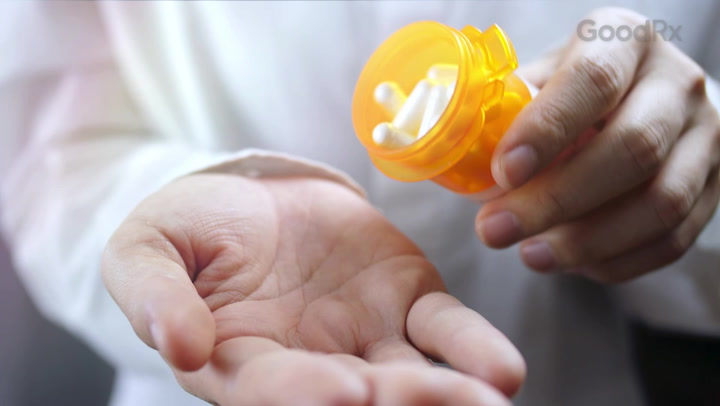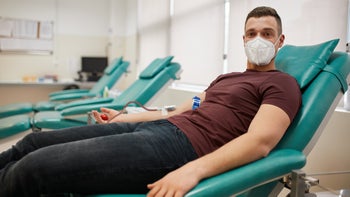
Swollen Feet? These 7 Medications Can Cause Puffy Legs and Ankles
Key takeaways:
Medications are a common reason for swollen ankles and feet, also called pedal edema. Amlodipine (Norvasc), gabapentin (Neurontin, Horizant, Gralise), and pregabalin (Lyrica) can cause puffy legs and ankles. Birth control pills, certain over-the-counter pain medications, and steroids are a few other culprits.
Lifestyle changes, including wearing compression socks, elevating your legs, or lowering your salt intake may help in certain situations. But in some cases, your prescriber may need to lower your dose or have you stop taking the medication.
Leg and ankle swelling can also be caused by blood clots and other serious medical conditions. Tell your healthcare team right away if you notice swelling so they can find the cause.
Table of contents
If you notice that your shoes are tight or that you have puffy legs, you may want to check your medication list. That’s because swelling in the legs and ankles (also called pedal edema) is a common side effect of some medications. Examples include amlodipine (Norvasc), gabapentin (Neurontin, Horizant, Gralise), and steroids like prednisone (Rayos).
Below, we’ll look at seven medications that commonly cause swollen ankles and legs. But keep in mind medications aren’t the only cause. Sometimes, swelling is caused by something more serious, like a blood clot or a medical condition getting worse.
1. Amlodipine
Amlodipine is a calcium channel blocker that’s prescribed for high blood pressure and chest pain. One of the most common amlodipine side effects is swelling in the legs. And this may be more likely if you’re taking a higher dosage (such as 10 mg daily) compared to a lower dosage.
In need of menopause symptom relief?
Get Premarin for over 55% less than the average retail price with GoodRx.

Your prescriber may suggest wearing compression socks or elevating your legs to help with swelling from amlodipine. But if it’s still an issue, they may try lowering your dose or switching you to a different medication.
2. Gabapentin
Gabapentin is a medication used to treat seizures, restless legs syndrome, and nerve pain from shingles. Some people taking it report fluid retention and swelling in their extremities. Swelling may be more likely if you’re older, or if you’re taking a higher gabapentin dosage.
Gabapentin isn’t approved for nerve pain from diabetes, but it’s sometimes prescribed off-label. One retrospective study found that people taking it for this reason had a higher risk of heart failure and other cardiovascular problems, possibly due to fluid retention. This was the case with short-term and long-term gabapentin treatment. But, more research is needed to know for sure.
Tell your prescriber if you notice swelling while taking gabapentin. They may decide to lower your dose or switch you to a different medication.
3. Pregabalin
Pregabalin (Lyrica) is similar to gabapentin. It’s used to treat different types of nerve pain, fibromyalgia, and seizures. It’s a controlled substance, meaning there’s a risk for abuse and dependence.
The same study mentioned above had similar findings with pregabalin. Taking pregabalin long term for diabetic nerve pain was associated with a greater risk of heart failure and other cardiovascular problems, possibly due to fluid retention.
Why it happens: Swelling in your legs can have many causes, from medications to health conditions. Here, experts break down why your legs may be swollen and when to see a healthcare professional about it.
Tips for relief: Learn more about solutions you can try to get rid of ankle swelling fast, including elevating your legs and wearing compression stockings.
Should you wear compression socks? Compression socks can improve blood flow and relieve leg swelling. Explore the different types of compression stockings and how or when to use them.
Leg swelling can happen if you’re taking pregabalin on its own. But it’s even more likely to happen if you’re taking pregabalin with glitazones. Glitazones are diabetes medications that can cause swelling and have also been linked to new or worsening heart failure.
Tell your prescriber if swelling develops so they can adjust your dose or switch you to a different medication.
4. Pioglitazone and rosiglitazone
Pioglitazone (Actos) and rosiglitazone (Avandia) are glitazone medications that are used to treat Type 2 diabetes. Leg swelling is a well-known side effect of these medications. And as mentioned above, this has been linked to a greater risk of heart failure.
If you experience swelling while taking pioglitazone or rosiglitazone, talk to your prescriber. They may be able to help switch you to a different diabetes medication.
5. NSAIDs
Nonsteroidal anti-inflammatory drugs (NSAIDs) can help treat pain and inflammation. Some are available over the counter (OTC), while others need a prescription. Examples include ibuprofen (Motrin, Advil), naproxen (Aleve, Naprosyn), and meloxicam (Mobic).
NSAIDs commonly cause water retention, which can lead to swelling in the legs and ankles. This tends to be more likely in older adults and people with kidney problems. Typically, the swelling will go away once you stop taking the medication.
But NSAIDs can also make heart failure worse. And worsening heart failure can cause leg and ankle swelling, too. If you have heart failure, don’t take an NSAID unless a healthcare professional prescribed it for you. And call them right away if you notice leg or ankle swelling.
6. Birth control pills
Estrogen-containing birth control pills can cause water retention, which may show up as swelling in the legs or ankles. This isn’t usually serious, but it’s important to know about other problems that may show up in a similar way.
While the overall risk is low, estrogen can raise your risk of a blood clot in your legs called a deep vein thrombosis (DVT). In addition to swelling, you may notice pain, redness, and/or warmth with a DVT. This is serious and needs to be treated quickly.
If you’re taking birth control pills and notice swelling in your legs, tell your healthcare team right away so they can figure out the cause. And if swelling becomes a problem, they can discuss possible non-hormonal birth control options with you.
7. Oral steroids
Oral steroid medications are used for a number of conditions, like asthma, chronic obstructive pulmonary disease (COPD), and severe allergic reactions. They’re also used for autoimmune disorders. Common examples include prednisone and dexamethasone (Decadron).
Steroids can help with swelling from inflammation. But they can also cause swelling in the legs and feet, as well as your hands and face (sometimes called “moon face”). For most people, this usually isn’t serious. But it can be more concerning if you have kidney disease or heart failure.
Many people only need to take an oral steroid for a short period of time. In this case, the swelling should go away after you stop taking it. But others may need to take steroids long term, and fluid retention may start affecting your blood pressure.
Eating salty foods can make swelling from steroids worse. Following the DASH diet can help you limit your sodium (salt) intake to lessen swelling. Be sure to attend any follow-up appointments with your healthcare team and tell them if you have any swelling.
When should you contact your prescriber about swelling in your legs?
For many people, swelling from a medication isn’t serious and will typically go away once you stop taking it. Depending on the medication, lifestyle changes or lowering your dose may help if it’s something you need to take long term.
But swelling can be concerning if you have other medical conditions, such as kidney disease or heart failure. And extra fluid in your body from retaining sodium and water can also raise your blood pressure.
In general, you should tell your prescriber if you notice swelling while taking a medication. They can help you figure out if it’s a problem for you and how to manage it.
Keep in mind: More serious issues, such as blood clots, can also show up as swelling in your legs. Contact your healthcare team immediately if the swelling becomes painful, comes on quickly, or feels warm to the touch. If it comes on with other concerning symptoms, like chest pain, palpitations, or shortness of breath, get medical attention right away.
Frequently asked questions
It depends on the cause and your health history. If you’re retaining water because you’re dehydrated, drinking more water could potentially help reduce swelling. But if it’s from certain health conditions, such as advanced kidney disease and heart failure, drinking more water can be dangerous. So it’s best to check with your healthcare team for guidance.
Certain foods and drinks can cause water retention, which can worsen swollen feet. Examples include:
Salty snacks, such as chips and salted popcorn
Processed foods, such as deli meats and frozen meals
Restaurant-prepared foods
Alcohol
Sugary foods, such as cookies and soda
Refined carbohydrates, such as white rice and white bread
The bottom line
Medications are one of the most common causes of swollen ankles and legs. Examples include amlodipine (Norvasc), nonsteroidal anti-inflammatory drugs (NSAIDs), and birth control pills. Gabapentin (Neurontin, Horizant, Gralise), pregabalin (Lyrica), and steroids like prednisone (Rayos) are also common culprits.
Swelling in the legs and ankles from medications isn’t usually dangerous. But sometimes puffy legs and ankles can be from a serious problem, such as a blood clot.
Tell your prescriber right away if the swelling becomes bothersome, or if it feels painful or warm to the touch. Get emergency medical attention if the swelling is accompanied by other symptoms, such as chest pain, fast or irregular heartbeats, or shortness of breath.
Why trust our experts?



References
Bryant Ranch Prepack. (2024). Pregabalin- pregabalin capsule [package insert].
Largeau, B., et al. (2021). Drug-induced peripheral oedema: An aetiology-based review. British Journal of Clinical Pharmacology.
Malik, A., et al. (2023). Congestive heart failure. StatPearls.
Page, R. L. II., et al. (2016). Drugs that may cause or exacerbate heart failure: A scientific statement from the American Heart Association. Circulation.
Pan, Y., et al. (2022). Cardiovascular risk of gabapentin and pregabalin in patients with diabetic neuropathy. Cardiovascular Diabetology.
Parsons, B., et al. (2004). Gabapentin: A pooled analysis of adverse events from three clinical trials in patients with postherpetic neuralgia. The American Journal of Geriatric Pharmacotherapy.
Was this page helpful?
Related Articles
Browse medications
View AllResearch prescriptions and over-the-counter medications from A to Z, compare drug prices, and start saving.

























